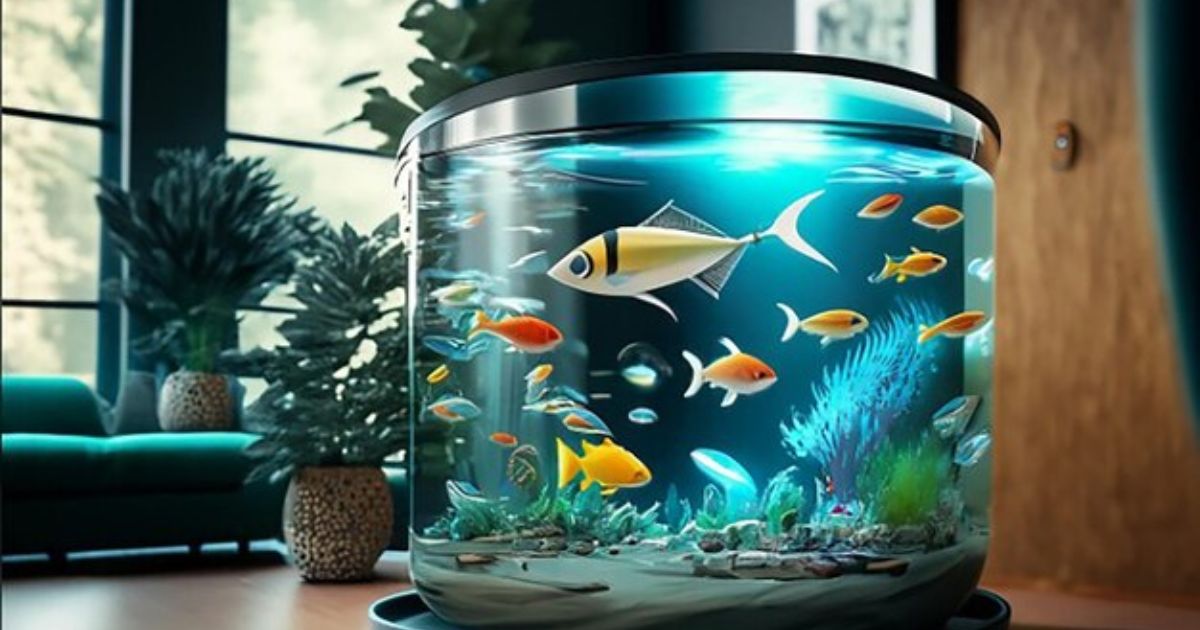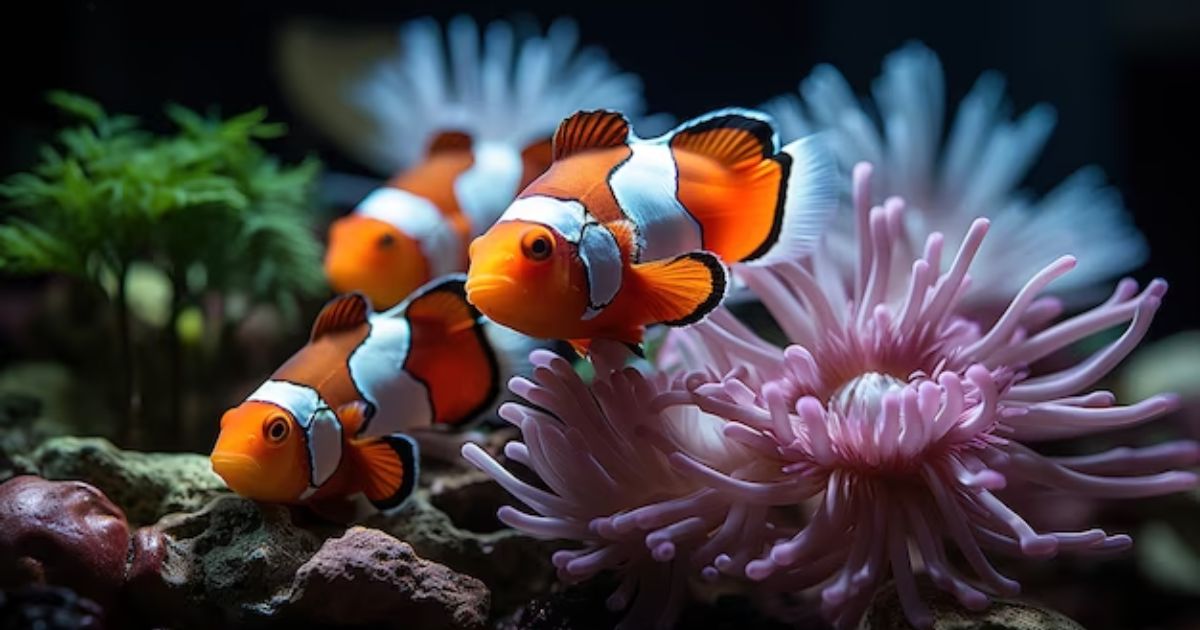Did you know that the number of clownfish you can keep in a tank depends on its size? Understanding the appropriate population limits is essential for maintaining a healthy and thriving aquarium. In this article, we will explore the ideal number of clown fish for different tank sizes, ranging from a 10-gallon to an 80-gallon tank. Whether you’re a beginner or an experienced aquarist, knowing the suitable clown fish count will help you create a harmonious and vibrant underwater environment.
Key Takeaways
- Tank size determines the number of clownfish that can be kept in a tank.
- Different clownfish species have varying space requirements and social behaviors.
- Overcrowding can lead to stress, aggression, and health problems among clownfish.
- Providing hiding places, suitable filtration, and monitoring behavior are crucial for the well-being of clownfish.
Tank Size for Clownfish

When determining the appropriate tank size for clownfish, it is essential to consider their natural habitat and behavior. Clownfish are found in the warm waters of the Pacific and Indian Oceans, particularly around coral reefs. They are known for their symbiotic relationship with anemones, seeking shelter and protection within their tentacles.
It’s important to note that the diet of clownfish primarily consists of small crustaceans and algae, and they are not known to eat bass fish. Understanding their dietary preferences is crucial for providing a well-balanced and suitable environment in your tank.
Thus, it is crucial to recreate a suitable environment in captivity to ensure their well-being. Clownfish are relatively small, with an average size of about three inches. For a single clownfish, a tank size of at least 20 gallons is recommended.
If you plan to keep a pair or a small group, a larger tank of 30-40 gallons will provide them with enough swimming space and territory. Providing ample space will promote their natural behavior, reduce aggression, and create a stress-free environment for these captivating creatures.
Clownfish Population Limits
Clownfish population limits in a tank depending on the tank size and the species of clownfish being kept. It is important to consider these factors to create a suitable and sustainable environment for the clownfish. Here are some key points to keep in mind:
- Tank size:
- A larger tank provides more swimming space and allows for a larger population of clownfish.
- Smaller tanks can only accommodate a limited number of clownfish, as overcrowding can lead to stress and aggression.
- Clownfish species:
- Different species have varying space requirements and social behaviors.
- Some species are more territorial and may not tolerate the presence of other clownfish, while others are more social and can coexist in larger groups.
Ideal Number of Clownfish in a 10-Gallon Tank
In a 10-gallon tank, the ideal number of clownfish can be determined based on the tank’s size and the specific needs of the clownfish species. It is important to consider the well-being and comfort of the clownfish, as overcrowding can lead to stress and health issues. For a 10-gallon tank, it is generally recommended to keep only one or a maximum of two clownfish.
This allows them enough space to swim and establish their territories. Additionally, clownfish are known to form strong social bonds, and having a pair in the tank can promote a sense of belonging and companionship. However, it is crucial to research the specific needs and compatibility of the clownfish species being kept, as different species may have varying requirements and behavioral tendencies.
Clownfish Quantity for a 20-gallon Tank
The appropriate number of clownfish for a 20-gallon tank will depend on the tank’s size and the specific requirements of the clownfish species. When considering the quantity of clownfish for a 20-gallon tank, it is important to take into account the following factors:
- Tank size: A 20-gallon tank can comfortably accommodate a pair of clownfish. It provides enough space for them to establish their territory and swim freely.
- Clownfish species: Different species of clownfish have varying space requirements. Some species, like the Ocellaris clownfish, are more adaptable and can thrive in smaller tanks, while others, like the Maroon clownfish, require larger tanks due to their territorial nature.
Considering these factors, a 20-gallon tank is best suited for a pair of clownfish. This allows them to form a bonded pair and establish their hierarchy within the tank. However, it is important to note that providing adequate hiding spaces and ensuring proper water quality is essential for the well-being of the clownfish.
Transitioning into the subsequent section about the number of clownfish in a 30-gallon tank, it is important to further explore the appropriate quantity for larger tank sizes.
Number of Clownfish in a 30-Gallon Tank

When considering the appropriate number of clownfish for a 30-gallon tank, it is important to take into account the tank’s size and the specific requirements of the clownfish species. A 30-gallon tank provides more space compared to a 20-gallon tank, allowing for a slightly larger number of clownfish.
It is still crucial to maintain proper stocking levels to ensure the health and well-being of the fish. Generally, a 30-gallon tank can comfortably accommodate up to three clownfish. It is essential to consider the size and activity level of the specific clownfish species, as some may require more space than others.
Adequate filtration and regular water changes are necessary to maintain optimal water quality in the tank. By considering these factors, you can create a suitable and harmonious environment for your clownfish.
Suitable Clownfish Count for a 40-gallon tank
Taking into account the size of a 40-gallon tank and the specific requirements of clownfish species, determining the appropriate number of clownfish can be done by considering factors such as tank space, fish size, and activity level, and maintaining optimal water quality.
- Tank Space: A 40-gallon tank can comfortably accommodate a small group of clownfish. It is recommended to have a maximum of 1 to 2 clownfish per 10 gallons of water. Therefore, a 40-gallon tank can house 4 to 8 clownfish.
- Fish Size and Activity Level: Clownfish are relatively small and can reach a size of 2 to 4 inches. It is important to consider their territorial nature and provide enough swimming space for each fish. Overcrowding the tank can lead to aggression and stress among the clownfish.
Maintaining optimal water quality is crucial for the health and well-being of the clownfish. Regular water changes, proper filtration, and monitoring of water parameters are essential to ensure a suitable environment for the clownfish community in a 40-gallon tank.
Recommended Clownfish Population in a 55-Gallon Tank
Determining the appropriate number of clownfish for a 55-gallon tank depends on factors such as tank space, fish size, and activity level, and maintaining optimal water quality. It is important to provide enough space for the clownfish to swim and establish territories, as overcrowding can lead to stress and aggression.
In a 55-gallon tank, a general rule of thumb is to have one clownfish per 10 gallons of water. However, it is crucial to consider the specific species of clownfish, as some are more territorial than others. Additionally, the size of the clownfish should be taken into account, as larger fish may require more space. The table below provides a guideline for the recommended number of clownfish in a 55-gallon tank:
| Clownfish Species | Recommended Number |
|---|---|
| Ocellaris | 4-6 |
| Percula | 2-4 |
| Maroon | 1 |
Maximum Number of Clownfish in a 75-Gallon Tank
The maximum number of clownfish that can be housed in a 75-gallon tank depends on various factors. These factors include the size of the clownfish, their aggression levels, and the overall health of the tank. It is important to create a suitable environment that promotes a sense of belonging for the clownfish.
For a 75-gallon tank, it is generally recommended to have a maximum of 1 to 2 clownfish. This allows for ample space and reduces the chances of aggression and stress. It is important to note that overcrowding a tank can lead to poor water quality and increased stress levels for the clownfish. Now, let’s explore the clownfish capacity in an 80-gallon tank.
Clownfish Capacity in an 80-Gallon Tank

To continue our exploration of clownfish capacity in different tank sizes, we now turn our attention to an 80-gallon tank. With its larger capacity, an 80-gallon tank provides more space and flexibility for housing clownfish. In this size tank, you can comfortably keep a larger number of clownfish compared to smaller tanks.
It is important to consider the specific needs and behaviors of clownfish to ensure their well-being. In an 80-gallon tank, it is recommended to have a maximum of 4 to 6 clownfish. This allows for a suitable social environment while preventing overcrowding, which can lead to stress and aggression. Remember to provide ample hiding places and appropriate filtration to maintain a healthy and harmonious clownfish community in your 80-gallon tank.
FAQ’s
Can I Mix Different Species of Clownfish in the Same Tank?
Mixing different species of clownfish in the same tank can be risky. While it may seem like a way to add diversity and color, it can lead to aggression and territorial disputes. It’s best to research compatibility and consult with a professional before attempting.
How Do I Introduce New Clownfish to an Existing Tank?
When introducing new clownfish to an existing tank, it is important to consider factors such as tank size, compatibility, and acclimation. Gradual introductions and monitoring for signs of aggression can help ensure a successful integration.
What Are the Signs of Aggression or Compatibility Issues Among Clownfish?
When evaluating aggression or compatibility issues among clownfish, it is essential to observe their behavior, such as chasing, biting, or fin-nipping. Signs of compatibility can include peaceful coexistence, sharing the same territory, and engaging in cooperative behaviors.
Are There Any Specific Tank Mates That Are Recommended or Not Recommended for Clownfish?
When considering tank mates for clownfish, it is important to choose species that are compatible and have similar care requirements. Some recommended tank mates include damselfish, gobies, and wrasses, while aggressive or territorial fish should be avoided.
How Often Should I Feed My Clownfish and What Type of Food Is Recommended?
When it comes to caring for clownfish, it is important to establish a regular feeding schedule. Experts recommend feeding them small amounts of high-quality food several times a day. A varied diet that includes both dry and frozen foods is recommended for optimal health.
Conclusion
In conclusion, determining the number of clownfish suitable for a tank depends on the tank size. It is important to consider the population limits and ideal numbers for different tank capacities. By understanding the appropriate clownfish count for each tank size, fish enthusiasts can ensure a healthy and thriving environment for these vibrant and playful creatures. With careful consideration and planning, one can create a harmonious and balanced ecosystem within their aquarium.

